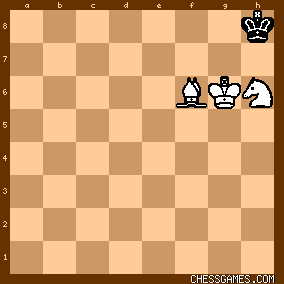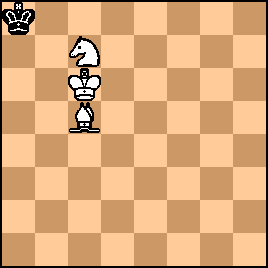fredthebear: This was my finish: 73.Be7 Kh8 74.Nf5 Kg8 75.Nh6+ Kh8 76.Bf6#
click for larger viewI learned the "W" method (or "Triangle method") from I.A. Horowitz books years ago by repeating his exact explanation on the board straight from the book every evening. Bruce Pandolfini has a good explanation in algebraic notation in his misnamed intermediate book "The ABCs of Chess." Here's a video that shows the "W" method: https://www.youtube.com/watch?v=hWw... Then when I practiced by myself (moving for both sides) without a book (we didn't have computer chess applications to practice against back then), I started the lone king trapped in the wrong color corner and gradually forced it along the edge into the bishop's mating corner. 
click for larger viewInitial self-training position, Black to move. (This is slightly different than 5:20 on the video.) First, I would practice against the lone king always attempting to return to the wrong color corner where it started. (The lone king always tries to move Left/Queenside or off-the-edge.) White must understand the role of the trailing bishop making a waiting move to pass the turn back to the lone king. Next time, I would practice against the lone king racing in the other direction ahead of the knight, striving to get ahead and escape into the middle. (The lone king always tries to move Right/Kingside or off-the-edge.) The knight's leading role is more difficult to learn than the bishop, as the knight changes colors every time it moves. There's more than one way to accomplish this forced mate, but it's not so easy as the example makes it look. In fact, I do not recommend teaching B+N+K vs K to beginners, for the time is better spent on drilling simpler, more common mates. Anything that takes 22-32 moves to accomplish is just not for beginners. Instead, beginners should read "Bobby Fischer Teaches Chess" 3-4 times until they're at least 95% accurate on their answers. BF makes it easy for beginners to succeed. It's far better to work on mates in 1-2-3 moves that are far more likely to occur. | 




